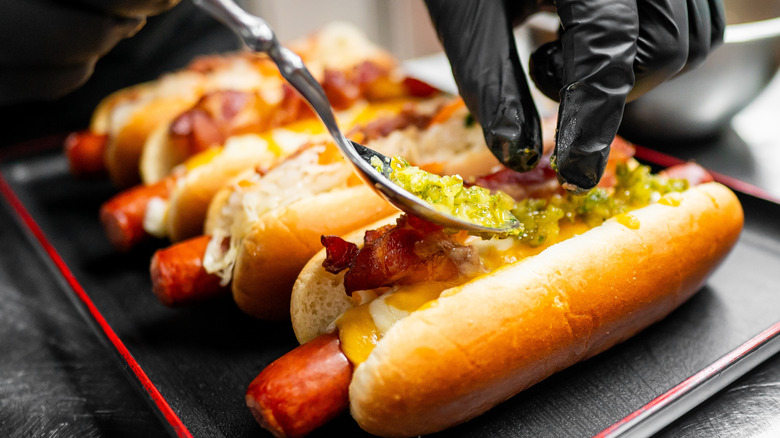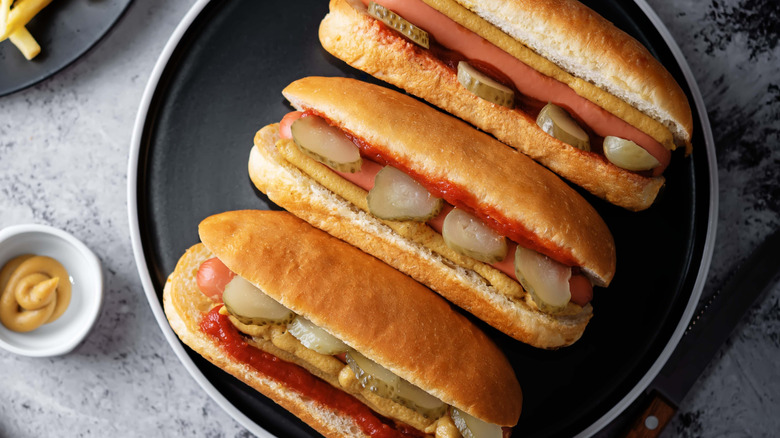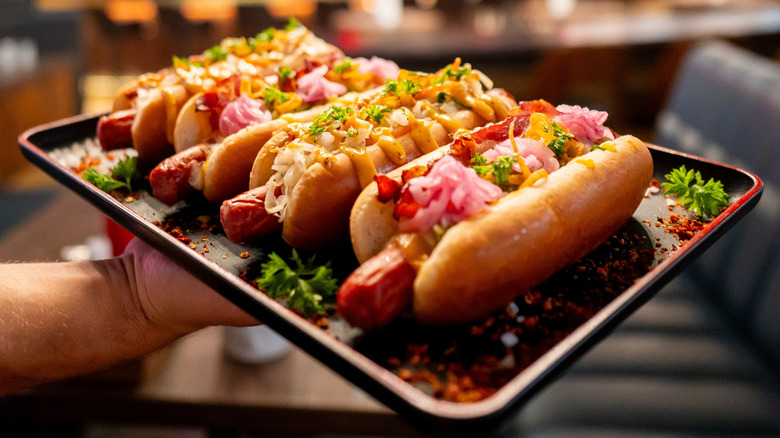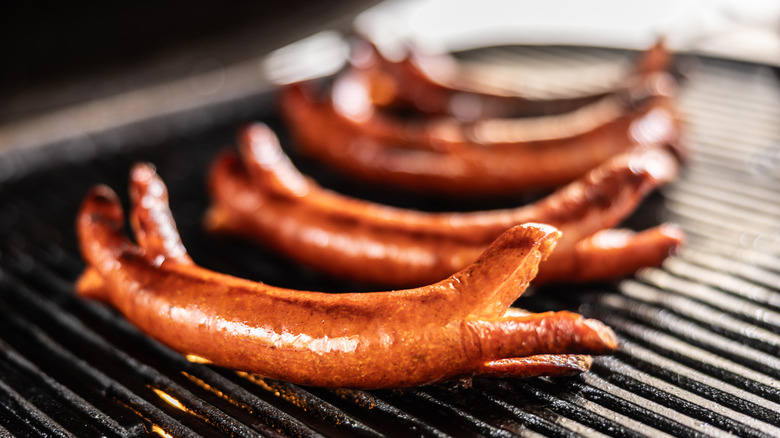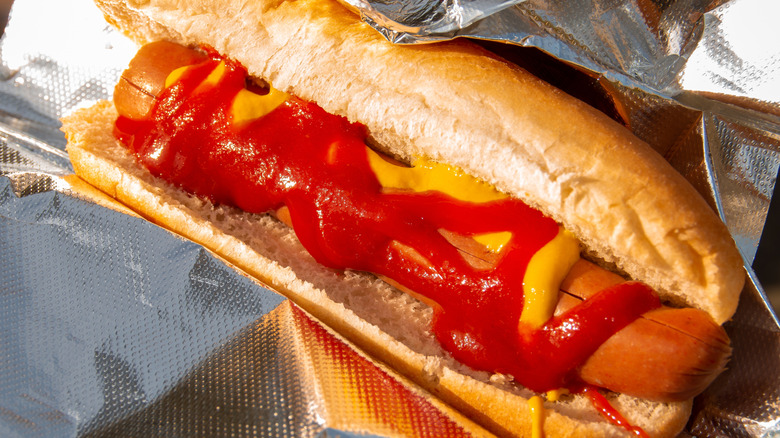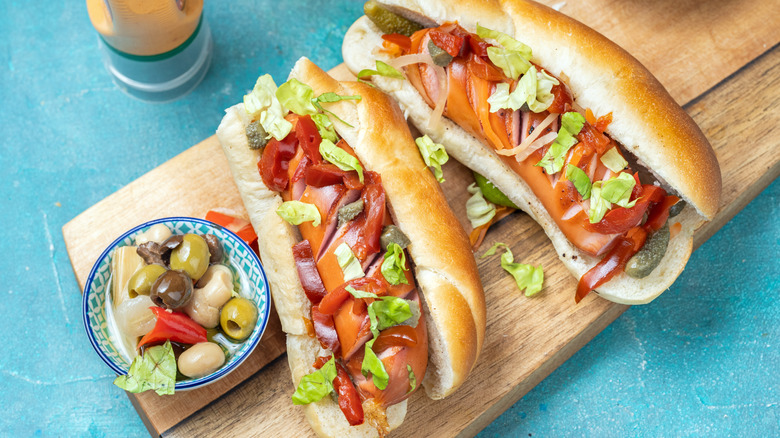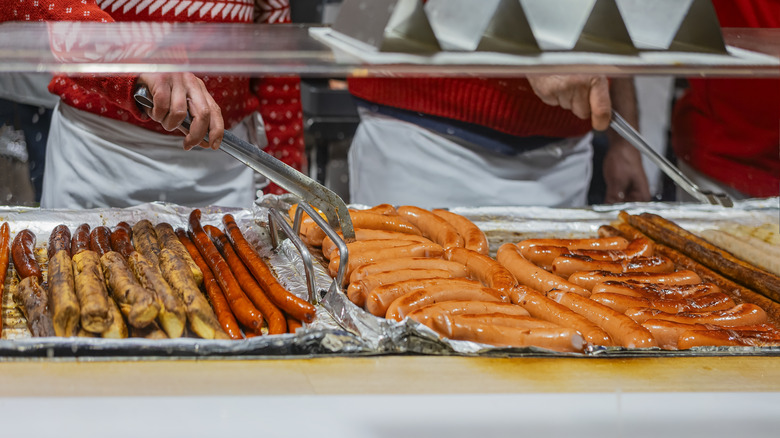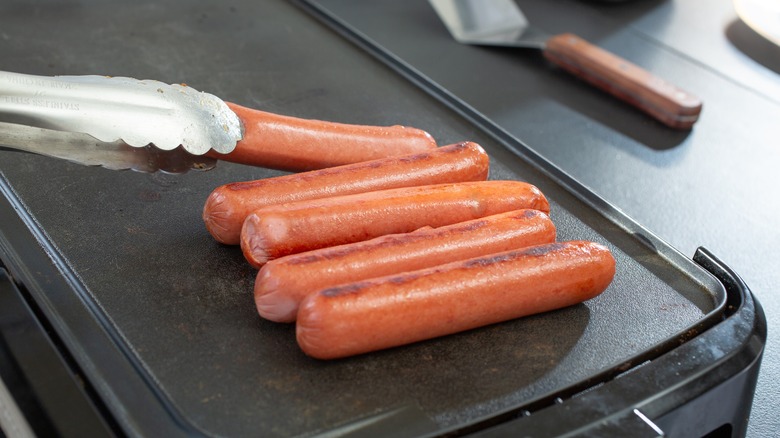Why Restaurant Hot Dogs Always Taste Better Than Homemade
Biting into a juicy, freshly cooked hot dog is one of the great, simple joys in life. However, homemade hot dogs can sometimes miss the mark, especially when compared to proper restaurant-made franks. With so many different elements to consider — the bun, assorted condiments, the correct preparation method, not to mention the dog itself — nailing down precisely why the hot dogs from your backyard barbecue don't measure up to professional fare can be tricky.
We decided to look into this conundrum and discovered quite a few explanations for why restaurant hot dogs hit the spot in a way that's hard to replicate at home. From fresher buns to more precise cooking methods, the pros have plenty of tips and tricks for those who want to elevate their hot dog game from the comfort of their kitchen (or backyard, for that matter). Once you've got these basics down, why not try to recreate some hot dog upgrades from celebrity chefs, like Emeril Lagasse's kimchi dogs or Martha Stewart's condiment-heavy sauerkraut dogs? Or, if you're feeling confident, you can experiment to find your own signature flavors for your hot dogs. Read on to discover the restaurant secrets for the best quality dogs and how you can improve the ones you make at home.
Restaurant buns are fresher
Nothing can harsh a hot dog's vibe more quickly than a stale bun. That dry, almost crinkly texture, familiar to anyone who's ever left a loaf of bread out for too long, is a disservice to your delicious, carefully prepared hot dogs — let alone all the tasty condiments you can pile on top. Despite what you may already believe about the bread-staling process, there's more afoot here than just a lack of moisture in the air.
The starch molecules in flour — bread's primary ingredient — form a rigid structure, and although this structure breaks down during the bread-making process when water is added, the starch molecules eventually return to that organized (or "crystallized") state once the water spreads to other areas of the bread. This is why storing your bread in the refrigerator is a big mistake: The cool (but not quite freezing) air in your fridge speeds up that dreaded crystallization process.
The restaurant-approved solution? Keep the bread warm and reintroduce moisture if necessary. Hot dog carts, for example, come equipped with steam tables that house lidded pans for hot dogs and buns. These pans are partially filled with water, which turns to steam once the pans are heated from underneath. This steaming method keeps the buns tasting fresh while protecting them from outside contaminants. To easily steam hot dog buns at home, either briefly place the buns in a double boiler or wrap each one in a damp paper towel and heat it in the microwave for 10 seconds or so.
Restaurant sausages are higher quality
You've no doubt heard the myth that hot dogs are made from the undesirable, leftover bits of animals, which suggests that even a standard hot dog is of questionable quality. Fortunately for hot dog lovers everywhere, this rumor is far from true. According to meat science expert and former hot dog plant employee Dr. Janeal Yancey, who spoke with Best Food Facts in 2015, "Most of the time, hot dogs are made with skeletal meat, which are trimmings of the same type of meat that makes ground meat, steaks and roasts."
While there may not be anything untoward inside your run-of-the-mill hot dog, if you have the means to level up your sausages' quality, why not try? The best restaurant hot dog you've ever had probably didn't source its sausage from a store-bought 24-pack that was on sale, and this difference in quality may be part of why restaurant dogs are so much tastier than the home-cooked version. Fast food chain Shake Shack, for example, sources its hot dogs from the Chicago-based brand Vienna Beef, which has relied on the same family recipe since 1893. This is also the brand of choice for Portillo's, which sells some of the highest-quality hot dogs in the business according to The Takeout.
Nathan's Famous is another high-quality brand worth seeking out (it's the official hot dog of the MLB, after all), and like Chicago's Vienna label, Nathan's Famous hot dogs are all-beef. Keep an eye out for this distinction the next time you're scoping out some franks in the supermarket.
Restaurants offer a wide variety of toppings and customization options
Hot dogs may be a barbecue and game-day staple here in the U.S., but that doesn't mean they always have to be the same. Depending on your region, a classic hot dog can come with any number of additions, from chili to onion sauce to a heavy-handed squirt of yellow mustard (which most Americans prefer over ketchup as a hot dog condiment). One way that restaurants love to level up their dogs is with unconventional yet perfectly paired toppings — and this is something that is easy to experiment with at home.
As just one example, Dog Haus, a gourmet hot dog restaurant in Pasadena, California, offers tasty yet varied creations like its Sooo Cali dog, which comes with arugula, tomatoes, crispy onions, and a spicy basil aioli. Its Old Town dog, on the other hand, comes topped with smoked bacon, caramelized onions, chipotle aioli, pickled jalapeños, and cotija cheese. Another example is Gray's Papaya in NYC. This place keeps it simple (yet still delicious) with a limited list of available toppings: ketchup, mustard, sauerkraut, onions, and relish.
Take cues from these restaurants if you're planning a hot dog bar for your next backyard bash: Offer a mix of fresh veggies, condiments, relishes, and sprinkle-on additions to give your guests some variety. You can even include a few standout ingredients like sauerkraut, kimchi, or pickled onions to elevate your bar to restaurant levels.
Restaurants don't dry out their hot dogs on a grill
This tip might be a bit controversial, but we're prepared to take the heat — just like hot dogs are meant to do. That's right, hot dogs are sold fully cooked, so all you have to do is warm them up (you could even eat them straight out of the package if you like — just don't mix them up with fresh sausages, which do require cooking). Grilling definitely accomplishes this primary goal of heating, but we would argue it's not the most ideal method for prepping your dogs. The issue is that high-heat grilling can dry out your sausages by drawing out their salt. If you're new to grilling or only break out the barbecue once or twice every summer, it's easy to accidentally overcook your hot dogs, and once they're dry, there's no going back. Since grill heat can be unwieldy, we recommend using other methods to achieve a really top-notch frank.
Just take a look at some popular hot dog purveyors if you need some inspiration. Ben's Chili Bowl in Washington D.C., for example, pan-fries its hot dogs with a bit of butter. If you're looking for a hot dog with a crisp, seared casing and a juicy interior, this method is the way to go. By doing this, you have maximum control over the heat, allowing you to watch the sausages more closely without getting distracted by grill adjustments. Caspers Famous Hot Dogs in the San Francisco Bay Area, on the other hand, steams its namesake protein, which still gives the casing that perfect bite (even without the sear marks) while keeping the interior juicy.
Restaurants wrap their assembled hot dogs in foil to aid the heating process
The process of heating your hot dog doesn't end when you remove it from the steamer (or pan, or pot, etc.). How you package, store, and transport your finished hot dog can be just as important as how you initially warm it up, and that's where foil comes in. If you're taking your dog on the go, wrapping it up is an easy way to keep it warm without drying it out. To do so, just place your heated hot dog in the bun, then loosely wrap the whole thing in foil. If you're preparing hot dogs ahead of time for a group, using this foil method before placing the wrapped dogs in a low-heat oven can keep them nice and steamy until your guests arrive.
Since hot dogs are such a portable food, this foil method — whether it's a single piece or a foil-lined bag — is common among quick-service restaurants and hot dog stands whose patrons are likely to eat on the move. If you're curious about the most efficient (and effective) way to wrap your hot dogs, Five Guys demonstrated its foil-wrapping technique in a video posted to Facebook. The video shows an employee placing an assembled hot dog just inside one corner of a flat foil square. They then roll the hot dog over until that corner is tucked underneath the bun, at which point they fold in the outer two corners and continue rolling. The result is a secure, perfectly portable hot dog that will stay warm for somewhere around 30 minutes.
Professionals don't overdo the condiments
Picture a restaurant hot dog — you can even make it a gourmet one, if you like. You're probably envisioning a perfectly cooked sausage in a nicely steamed bun piled high with gratuitous toppings, from crispy onions to leafy greens to sauces that probably have fancy French names. While some upscale establishments may sell dogs like this for spectacle, those committed to hot dog quality will probably tell you that crafting the perfect frank is all about the balance of flavors, not the quantity of the toppings.
The Turano Baking Company, for example, shared in a Facebook reel that regional hot dogs aren't just about how the dogs are cooked — they're also all about the toppings. "The biggest part of being a Chicago-style hot dog is what you put on it," the video's narrator says, adding, "and what you don't put on it," while shaking a finger at a bottle of ketchup. The chef later reveals that they watch out for salinity when adding toppings to their classic Chicago dogs. "You don't want to overdo it with any one item," they said. "You don't want it drenched with mustard or relish. ... The hot dog is salty in itself, so it's just like a little added zest." Ensuring that your franks are well-dressed — both quality- and quantity-wise — is a great way to level up your hot dog game. There's a fine line between under and overdoing it, but consider what condiments will compliment the dog, not overwhelm it.
Restaurants serve their hot dogs at just the right temperature
You've probably heard the guidance that meat must reach an internal temperature of 165 degrees Fahrenheit before it's safe to eat. This is definitely true for poultry like chicken and turkey, as the high temperature (combined with sufficient cooking time) eliminates dangerous bacteria like Salmonella and E. coli. Beef and pork are a little different, however, as they only need to reach an internal temperature of 145 degrees Fahrenheit to reach that safety threshold. But what does this mean for hot dogs, and how do restaurants know when they're done cooking?
As mentioned previously, hot dogs are already fully cooked when you take them out of the package, meaning your only job is to heat them up. This means texture and appearance can take center stage. According to online consensus, between 155 and 160 degrees Fahrenheit is the sweet spot for your reheated franks.
Even if you don't own or use a meat thermometer, which both we and the USDA highly recommend, you can still rely on a few rules of thumb if you're unsure how long to cook your dogs. Steaming should only take about 4 to 5 minutes once the water is hot, whereas grilling only takes 1 to 2 minutes on each side of the hot dog. The oven can take a bit longer (Nathan's Famous recommends baking them for about 15 minutes at 400 degrees Fahrenheit), but if you're down to try the microwave, heating your franks should only take about 50 seconds. Basically, once your hot dogs look plump and steamy, they should be good to go.
Some restaurants cook their hot dogs on a griddle
We've recommended a few methods thus far for perfectly heating your hot dogs, like pan frying and steaming. While we wouldn't necessarily include grilling on that list considering how easily it can dry out your hot dogs, we would include a stint on a hot griddle as an ideal cooking technique. Unlike grills, griddles don't directly expose your hot dogs to open flames, and this exposure is how your hot dogs become woefully charred and dry. Additionally, griddles can cook food much more evenly than an open-flame grill, meaning you can achieve the same level of doneness on a large batch of hot dogs without worrying about direct versus indirect heat or making temperature adjustments.
When Chowhound explained why you should stop grilling and boiling your hot dogs, the writer recommended cooking them on a griddle instead, a tip they credited to pro chef Fred Maurer of NYC's NoMad Diner. "My preference for a hot dog is more about the dog than the fillings," Maurer told The Kitchn in 2024. "But whatever the dog, [it should be] boiled or griddled with butter. Never grilled."
To perfectly griddle your hot dogs, the New York chef recommends splitting them lengthwise so they can lay flat, then placing them on a buttered griddle at medium-high heat for 2 to 3 minutes per side. To ensure each dog is seared evenly, Maurer suggests placing a weighty pan on top of the butterflied franks — a technique that will also minimize the number of flips needed to cook their entire surface area.
The pros apply toppings to the dog, not the bun
If you learn anything from this hot dog deep dive, let it be the maxim that toppings are half the battle. This doesn't just mean choosing what crunchy, smooth, sweet, or acidic delights top your perfectly steamy frank, but also choosing the order in which you apply them. If you're a hot dog novice (or just aren't very adventurous in the frankfurter realm), you might be content just squirting a bit of mustard or spreading a bit of pickle relish directly onto the bun. According to the pros, however, this is a major faux pas.
The National Hot Dog and Sausage Council, in an article detailing hot dog etiquette, had this to say about the topping process: "Always 'dress the dog,' not the bun." This means arranging your condiments and add-ons on top of the hot dog itself, not underneath it or on the side of the bread. While the NHDSC doesn't reveal why this protocol is so important, we can only assume the order in which toppings are applied can impact the texture and structural integrity of the dog — for example, mustard applied underneath the dog may make the bun soggy and the sausage itself unnecessarily slippery.
As for how to amend your topping habits, the NHDSC recommends applying add-ons in the following order: "[W]et condiments like mustard and chili are applied first, followed by chunky condiments like relish, onions and sauerkraut, followed by shredded cheese, followed by spices, like celery salt or pepper." Even if your preferred toppings don't appear anywhere on the council's list, it's still a useful guideline for crafting a clean, professional-looking frank at your next barbecue.
Static Media owns and operates Mashed and The Takeout.
